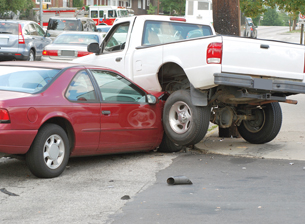Module 2
1. Module 2
1.1. Big Picture
Module 2—The Conservation of Momentum in Isolated Systems
 Big Picture
Big Picture

S. Meltzer/Photolink/Getty Images
In Module 1 you explored the need for better-designed vehicle safety devices to keep our roads safe. If you have ever been in a car accident or know someone who has, you know that collisions can happen suddenly and are over very quickly. In some cases, experts are called in to decide who may be at fault and to establish responsibility for the associated costs of an accident. In this process, scientific principles such as the conservation of momentum are applied to develop an approximate reconstruction of the events just prior to a collision. This reconstruction is important for establishing why and how a collision occurred.
Consider what happens after a vehicle collision:
-
Two vehicles collide at an intersection. The vehicle mass is scattered about and various forces act, producing heat, sound, and deformation of metal, plastic, and glass. The tires skid across the pavement and chunks of debris are thrown upwards into the sky. Hot metal fragments cool down as the wreckage waits to be cleared.
-
An ambulance arrives at the scene to treat the injured. The police take numerous photographs of the scene, measure skid marks, and note the temperature and road conditions. Investigators estimate vehicle masses and note debris patterns.
-
Investigations determine relevant events at the time of the collision and establish fault.
The investigation into the events just prior to the collision is based on the conservation of momentum, a principle that perfectly describes collisions that occur in isolated systems. An isolated system is one in which no mass enters or leaves the system, and no net external force acts on it. You will learn more about this in a later lesson, but such a system is not readily found on our planet (curling stones on a totally frictionless sheet of ice would be a good approximation). And although we know cars don’t collide like curling stones, we could analyze car collisions in a similar way, assuming the system to be isolated just at the moment of impact. This assumption allows us to apply scientific principles to produce a reasonable approximation of events for a vehicle crash. In this module we will learn how to use the conservation of momentum to analyze and reconstruct collisions in both one and two dimensions.
Case File

© Katherine Welles/shutterstock
On October 1, Kathy Johnson (not her real name) was driving home from work in her red car. As she approached the University Drive intersection, Bill Peterman (not his real name), driving his white pickup truck, attempted to cross the same intersection on his way to class. Unfortunately, they collided in the centre of the intersection.
As seen in this photo, both vehicles became joined and moved off to the side of the intersection before coming to rest. When the police arrived and began taking statements, Bill claimed that Kathy was well back from the intersection when he attempted to cross and that her high rate of speed was to blame for the accident. At the same time, Kathy insisted she was travelling at the posted speed limit, 50 km/h, and that Bill entered the intersection without proper care and attention.
Both Kathy and Bill received medical attention for non-life-threatening injuries. The property damage to both vehicles was substantial. The case is now before the courts to decide who will pay for the damages. In addition, the police have charged Kathy with driving in excess of the posted speed limit.
In her defence, Kathy has hired a consultant to perform a crash analysis hoping that it will confirm her speed prior to the collision. The intent of this analysis is to prove, beyond a reasonable doubt, that she was actually travelling at the speed limit just prior to the accident. How is this possible? How can conservation principles related to momentum and energy be applied to analyze and understand collisions?
You will refer to this case study as part of your Module 2 Project throughout the lessons of Module 2.
Essential Questions
As you are working in Module 2, keep the following questions in mind:
-
How is the conservation of momentum principle applied to linear collisions?
-
Is it possible to describe mathematically the difference between elastic and inelastic collisions using kinetic energy?
-
How are the conservation of momentum principle and vector component analysis applied to solve non-linear collisions?
 Module Assessment
Module Assessment
Each lesson has a teacher-marked assignment, based on work completed in the lesson. In addition, you will be graded on your contributions to the Discuss section of each lesson.
You will also be asked to complete Self-Check or Try This questions, which you should place in your Physics 30 course folder. These are not formally assessed but are a valuable way to practise the concepts and skills of the lesson. These activities can provide you with reflective feedback on your understanding of the lesson work.
You will be marked for your lesson work on the following items:
-
Module 2: Lesson 1 Assignment
-
Module 2: Lesson 2 Assignment
- Module 2: Lesson 3 Assignment
-
Module 2 Project
In each lesson you will prepare a crash analysis for your Module 2 Project of the collision between Kathy and Bill described in the Big Picture section. The analysis should be complete at the end of Lesson 3. It must show a complete solution for the mathematical determination of Kathy's speed just prior to the collision. If you have any questions contact your teacher.